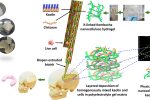
3D Printed SCOBY Bioink for Direct Tissue Repair
3dprintingindustry.com
Researchers at Seoul National University of Science and Technology (SEOULTECH) have developed a Kombucha SCOBY (Symbiotic Culture of Bacteria and Yeast) bioink that could streamline in vivo tissue engineering. Published in the International Journal of Biological Macromolecules on December 1, 2024, the study outlines how nanocellulose from SCOBY can be partially hydrolyzed, reinforced with chitosan and kaolin, and printed onto irregular wounds using a hand-held device called the Biowork biopen.Kombucha SCOBY produces cellulose during tea fermentation, resulting in nanocellulose with biodegradable and cell-compatible properties. However, the default entangled structure can be difficult to extrude. The team, led by Professor Insup Noh, used acetic acid to loosen the nanocellulose fibers (partial hydrolysis), improving flow through fine nozzles but simultaneously reducing the materials mechanical strength.To restore structural stability, they introduced chitosan (a positively charged polymer) and kaolin (a negatively charged clay). Electrostatic interactions among these three componentsnanocellulose, chitosan, and kaolincreated a polyelectrolyte complex without the need for chemical crosslinkers. According to the published paper, tests showed the resulting hydrogel could withstand typical mechanical stresses encountered in soft tissue applications.Graphical Abstract. Image via International Journal of Biological Macromolecules.Hand-Held Biopen for Real-Time MixingThe Biowork biopen features two counter-rotating screws that mix nanocellulose, reinforcing particles, and live cells moments before extrusion. This real-time blending removes the need for lengthy pre-mixing, potentially speeding up clinical workflows. Professor Insup Noh, who also heads MatrixCell Bio Inc., a firm focusing on biomaterials and regenerative devices, stated, This technology allows for a quick and easy one-step process where the drug and hydrogel are mixed and immediately applied on-site to injured areas of different shapes.In demonstration models of cranium and femoral head defects, the bioink maintained its layer-by-layer architecture above one centimeter in height. Researchers recorded stable deposition even on irregular surfaces, suggesting that the chitosan-kaolin network provided effective cohesion in spite of the partial hydrolysis. Cell viability also remained high, which the team attributed to the gentler blending forces inside the twin-screw mechanism.Investigations so far suggest that Kombucha SCOBY-derived nanocellulose can form the basis of a 3D printing platform with potential use in in vivo treatments. The systems reliance on electrostatic bonding between cellulose, chitosan, and kaolin removes additional crosslinking steps that might complicate procedures or introduce foreign agents.Tissue regeneration with Kombucha-SCOBY. Image via International Journal of Biological Macromolecules.Future Directions and Practical ImplicationsThe research team plans further exploration of this bioink, including tests on larger or more complex tissue defects. Adjusting viscosity, mechanical properties, and biological additives may tailor the formulation for specific clinical needs, such as cartilage regeneration, skin reconstruction, or wound healing in emergency settings. Early feedback from tests on anatomically shaped models indicates that uniform mixing in the Biowork biopen could help ensure consistent cell distribution, which is often difficult in standard syringe-based methods.Observations reported in the article do not draw conclusions about long-term tissue integration or clinical efficacy. Instead, they focus on the ability of this hydrogel to maintain shape, support viable cells, and fill irregular defects without using a separate crosslinker. Ongoing collaborations with medical researchers may clarify next steps for translating the method into clinical trials.SEOULTECH is a national university located in Nowon-gu, Seoul, South Korea. Established in April 1910, it has grown to span more than 500,000 m and now includes 10 undergraduate schools and 6 graduate schools serving around 14,595 students. Research programs focus on engineering, science, and technology, fostering interdisciplinary efforts like those led by Professor Nohs group in chemical and biomolecular engineering.SEOULTECH logo. Image via Seoul National University of Science & Technology.Ready to discover who won the 20243D Printing Industry Awards?What will the future of 3D printing look like?Which recent trends are driving the 3D printing industry, as highlighted by experts?Subscribe to the 3D Printing Industry newsletter to stay updated with the latest news and insights.Stay connected with the latest in 3D printing by following us on Twitter and Facebook, and dont forget to subscribe to the 3D Printing Industry YouTube channel for more exclusive content.Featured image shows Graphical Abstract. Image via International Journal of Biological Macromolecules.
0 Commentarios
·0 Acciones
·66 Views


